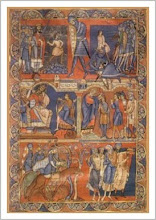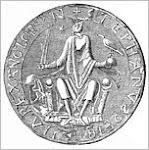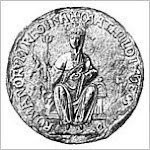• William the Conqueror - Matilda of Flanders
William I, the Conqueror
Reign: 1066-1087
Birth: 1027/1028, Falaise, Normandy, France
Death: 7 September 1087, Rouen, France
Burial: St Stephen Abbey, Caen, Normandy
Father: Duke Robert of Normandy
Mother: Herleva (Arlette)
Marriage: 1053 - Matilda of Flanders
Children:
Robert Curthose, Duke of Normandy
Richard
William II Rufus, King of England
Cecilia (or Cecily), Abbess of Holy Trinity, Caen
Agatha
Adeliza (or Alice)
Alison (or Ali)
Adela, m. Stephen, Count of Blois
Matilda
Constance, m. Alan IV Fergent, Duke of Brittany
Henry I Beauclerc, King of England and Duke of Normandy
NOTES: Duke William of Normandy. William was the illegitimate son of Robert I, Duke of Normandy and Herleva or Arlette, a tanner's daughter, and sometimes called "William the Bastard". He was the first Norman King of England. On 28th September 1066 William secured the sanction of Pope Alexander II for a Norman invasion of England. He was victorious at The Battle of Hastings on 14th October 1066 and by 1070 the Norman conquest of England was complete. The Normans introduced into England their system of land tenure based on military service. They were administrators rather than legislators, and the whole system of Saxon local government - the counties, sheriffs, and courts - survived. Norman and Saxon institutions were blended. The smooth working of the feudal system depended on a king's ability to control his vassals. William was astute in his selections and to further strengthen his position he distributed their estates over various parts of the kingdom so that there was no great concentration of power. The only exception to this measure was along the unsettled borders of Wales and Scotland. It was the 'Marcher Lords' who posed the biggest danger to royal authority and after the revolt of the Earl of Hereford William exacted an oath which made each tenant directly responsible to the king. This was a severe restriction of the powers of his tenants in chief. In addition the chief clergymen of the church were almost entirely replaced by Normans. For example, Lanfranc replaced the English Archbishop of Canterbury and under him a great period of building began. William ordered the compilation of the 'Domesday Book' in 1086, a detailed survey of all the manors of England showing who held them, their size, number of villeins, amount of stock and value.
William the Conqueror died at The Convent of St Gervais near Rouen in 1087. It's been stated that he died as a result of injuries he sustained when he was either thrown hard against the pommel of his saddle or from being thrown from his horse. His burial was just as marred by strife as his coronation 21 years before in December 1066. Apparently his stone tomb had been made too small to fit his body, requiring it to be ineptly squashed into the chamber. William was buried in the Abbaye aux Hommes, which he had founded, in Caen, Normandy. His grave was defiled and his bones scattered in the mid 1500's and again during the French Revolution - a rather inglorious end for William the Conqueror.
Matilda of Flanders
Born: c.1031
Died: 1083
Burial: l'Abbaye aux Dames, Caen, Normandy
Father: Baldwin V, Count of Flanders
Mother: Adela Capet, daughter of Robert II of France
Marriage: William I the Conqueror
NOTES: Matilda of Flanders, Queen consort of England and wife of William I the Conqueror, was a seventh generation direct descendant of Alfred the Great and her marriage to William strengthened his claim to the throne.
Matilda was said to be diminutive, perhaps only approximately 5 feet tall, but it seems she was a feisty person. According to legend, she told the representative of William Duke of Normandy who had come asking for her hand that she was far too high born to consider marrying a bastard. Apparently William himself sought her out and roughed her up. There are several versions of the story:
1. William rode from Normandy to Bruges and found Matilda on her way to church. He dragged her off her horse by her long braids, threw her down in the street, and then rode off.
2. William rode to her father Baldwin's home in Lille, threw Matilda to the ground by the braids, and then violently shook or hit her before leaving.
Whatever the real story may be, Matilda decided to marry William. A papal ban on the grounds of consanguinity did not dissuade either, and they were married in 1053 and Matilda bore him eleven children.
During the time William was preparing to invade England Matilda outfitted a ship called the Mora out of her own money and gave it to him, and at one time it was thought that she was involved in the creation of the Bayeux Tapestry but it's now believed that it was commissioned by William's half brother Odo, Bishop of Bayeux. She died in 1083 and was buried at l'Abbaye aux Dames, which she had founded, in Caen.
• The Anglo-Saxon Chronicle: William I
Subscribe to:
Post Comments (Atom)








No comments:
Post a Comment